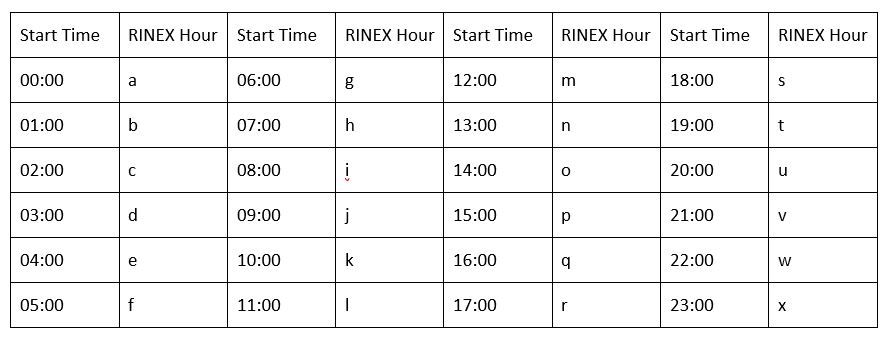5.1. RINEX Files Naming Convention for GNSS Observations

Fig. 5.1 RINEX File Header
When a GNSS observable file is uploaded, OPUS attempts to convert the file into RINEX (Receiver INdependent EXchange) format, shown in Fig. 5.1, if it is not already in that format. In converting an observable file to RINEX, OPUS will rename the file using the standard naming conventions aaaadddb.yyo
aaaa is the unique four-character mark ID (alphanumeric) assigned to each user mark in the project. This comes from the first four characters of the file that is uploaded to OPUS. To easily associate observation files to specific user marks, make sure to start the observation file name with a four-character ID for the mark. Otherwise, the user can still assign this Mark ID within OPUS-Projects by clicking on the “Change Mark ID” utility.
ddd is the day-of-year of the start of the day (numeric), this is sometimes called the Julian Day number
b is a letter representing the starting hour of the data in UTC (a = 00, b = 01, c = 02, …, x = 23 and special case 0 = 24 hr data set), as shown in Fig. 5.2.

Fig. 5.2 RINEX UTC hour naming convention
yy is the two digit year (numeric)
o identifies the file as a GNSS observation file (as opposed to the n, the navigation file)
The four-character mark ID is the first four characters of the uploaded file. OP will also assign each point observed with this same four-character ID. Therefore, each GNSS observable file should already be named starting with its respective four-character mark ID.
Danger
Make sure to name each GNSS data file so that the name begins with a four-character ID you wish to assign to each project mark in your survey. That will ensure consistency between data files and project marks in OP
Using this naming convention, a sample RINEX file would be named g287009q.23o
g287 would be the user mark’s four-character ID
009 would refer to an observation started on January 9
q would refer to 16:00 UTC (observation file start time)
23 would refer to the calendar year 2019
o refers to the GNSS observation file
If OPUS cannot convert the file to RINEX successfully, an error message will be displayed. You may have to convert the file yourself using software from your receiver vendor.